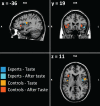An fMRI study on the influence of sommeliers' expertise on the integration of flavor
- PMID: 25360093
- PMCID: PMC4199283
- DOI: 10.3389/fnbeh.2014.00358
An fMRI study on the influence of sommeliers' expertise on the integration of flavor
Abstract
Flavors guide consumers' choice of foodstuffs, preferring those that they like and meet their needs, and dismissing those for which they have a conditioned aversion. Flavor affects the learning and consumption of foods and drinks; what is already well-known is favored and what is new is apprehended. The flavor of foodstuffs is also crucial in explaining some eating behaviors such as overconsumption. The "blind" taste test of wine is a good model for assessing the ability of people to convert mouth feelings into flavor. To determine the relative importance of memory and sensory capabilities, we present the results of an fMRI neuro-imaging study involving 10 experts and 10 matched control subjects using wine as a stimulus in a blind taste test, focusing primarily on the assessment of flavor integration. The results revealed activations in the brain areas involved in sensory integration, both in experts and control subjects (insula, frontal operculum, orbitofrontal cortex, amygdala). However, experts were mainly characterized by a more immediate and targeted sensory reaction to wine stimulation with an economic mechanism reducing effort than control subjects. Wine experts showed brainstem and left-hemispheric activations in the hippocampal and parahippocampal formations and the temporal pole, whereas control subjects showed activations in different associative cortices, predominantly in the right hemisphere. These results also confirm that wine experts work simultaneously on sensory quality assessment and on label recognition of wine.
Keywords: expertise; fMRI; flavor; olfaction pathways; taste; wine.
Figures




References
-
- Ballester J., Patris B., Symoneaux R., Valentin D. (2008). Conceptual vs. perceptual wine spaces: does expertise matter? Food Qual. Prefer. 19, 267–276. 10.1016/j.foodqual.2007.08.001 - DOI
LinkOut - more resources
Full Text Sources
Other Literature Sources
Medical

